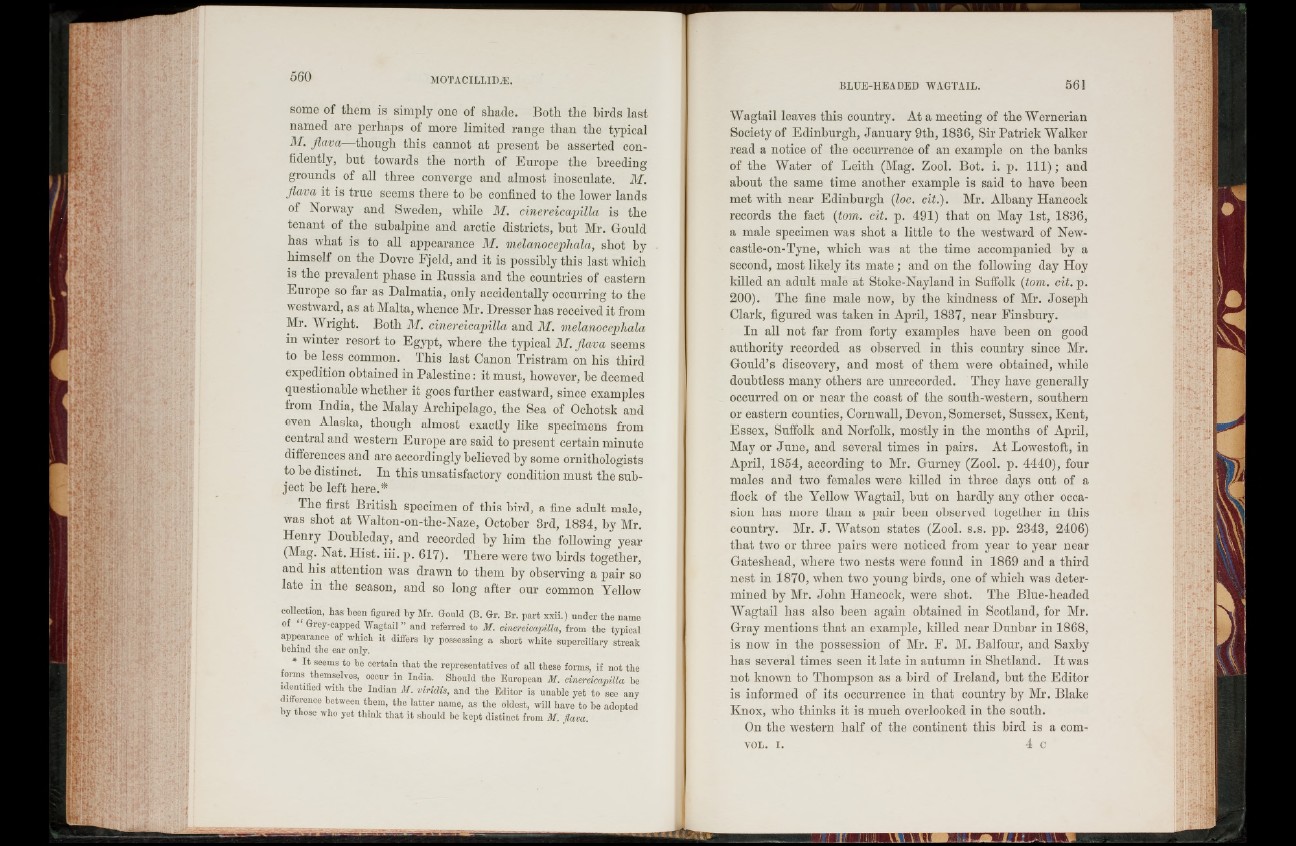
some of them is simply one of shade. Both the birds last
named are perhaps of more limited range than the typical
M. flava—though this cannot at present he asserted confidently,
but towards the north of Europe the breeding
grounds of all three converge and almost inosculate. M.
flava it is true seems there to be confined to the lower lands
of Norway and Sweden, while M. cinereicapilla is the
tenant of the subalpine and arctic districts, but Mr. Gould
has what is to all appearance M. melanocephala, shot by
himself on the Dovre Fjeld, and it is possibly this last which
is the prevalent phase in Russia and the countries of eastern
Europe so far as Dalmatia, only accidentally occurring to the
westward, as at Malta, whence Mr. Dresser has received it from
Mr. Wright. Both M. cinereicapilla and M. melanocephala
in winter resort to Egypt, where the typical M. flava seems
to be less common. This last Canon Tristram on his third
expedition obtained in Palestine: it must, however, be deemed
questionable whether it goes further eastward, since examples
from India, the Malay Archipelago, the Sea of Ochotsk and
even Alaska, though almost exactly like specimens from
central and western Europe are said to present certain minute
differences and are accordingly believed by some ornithologists
to be distinct. In this unsatisfactory condition must the subject
be left here.*
The first British specimen of this bird, a fine adult male,
was shot at Walton-on-tlie-Naze, October 3rd, 1834, by Mr.
Henry Doubleday, and recorded by him the following year
(Mag. Nat. Hist. iii. p. 617). There were two birds together,
and his attention was drawn to them by observing a pair so
late in the season, and so long after our common Yellow
collection, has been figured by Mr. Gould (B. Gr. Br. part xxii.) under the name
o ley-capped Wagtail” and referred to M. cinereicapilla, from the typical
appearance of which it differs by possessing a short white superciliary streak
behind the ear only.
* I t seems to be certain that the representatives of all these forms, if not the
forms themselves, occur in India. Should the European M. cinereicapilla be
identified with the Indian M. viridis, and the Editor is unable yet to see any
ifference between them, the latter name, as the oldest, will have to be adopted
by those who yet think that it should be kept distinct from M. flava.
Wagtail leaves this country. At a meeting of the Wernerian
Society of Edinburgh, January 9tli, 1836, Sir Patrick Walker
read a notice of the occurrence of an example on the banks
of the Water of Leith (Mag. Zool. Bot. i. p. I l l ) ; and
about the same time another example is said to have been
met with near Edinburgh (loc. cit.). Mr. Albany Hancock
records the fact (tom. cit. p. 491) that on May 1st, 1836,
a male specimen was shot a little to the westward of Newcastle
on-Tyne, which was at the time accompanied by a
second, most likely its ma te; and on the following day Hoy
lulled an adult male at Stoke-Nayland in Suffolk (tom. cit. p.
200). The fine male now, by the kindness of Mr. Joseph
Clark, figured was taken in April, 1837, near Finsbury.
In all not far from forty examples have been on good
authority recorded as observed in this country since Mr.
Gould’s discovery, and most of them were obtained, while
doubtless many others are unrecorded. They have generally
occurred on or near the coast of the south-western, southern
or eastern counties, Cornwall, Devon, Somerset, Sussex, Kent,
Essex, Suffolk and Norfolk, mostly in the months of April,
May or June, and several times in pairs. At Lowestoft, in
April, 1854, according to Mr. Gurney (Zool. p. 4440), four
males and two females were killed in three days out of a
flock of the Yellow Wagtail, but on hardly any other occasion
has more than a pair been observed together in this
country. Mr. J . Watson states (Zool. s.s. pp. 2343, 2406)
that two or three pairs were noticed from year to year near
Gateshead, where two nests were found in 1869 and a third
nest in 1870, when two young birds, one of which was determined
by Mr. John Hancock, were shot. The Blue-headed
Wagtail has also been again obtained in Scotland, for Mr.
Gray mentions that an example, killed near Dunbar in 1868,
is now in the possession of Mr. F. M. Balfour, and Saxhy
has several times seen it late in autumn in Shetland. I t was
not known to Thompson as a bird of Ireland, but the Editor
is informed of its occurrence in that country by Mr. Blake
Knox, who thinks it is much overlooked in the south.
On the western half of the continent this bird is a comv
o l . i. 4 c